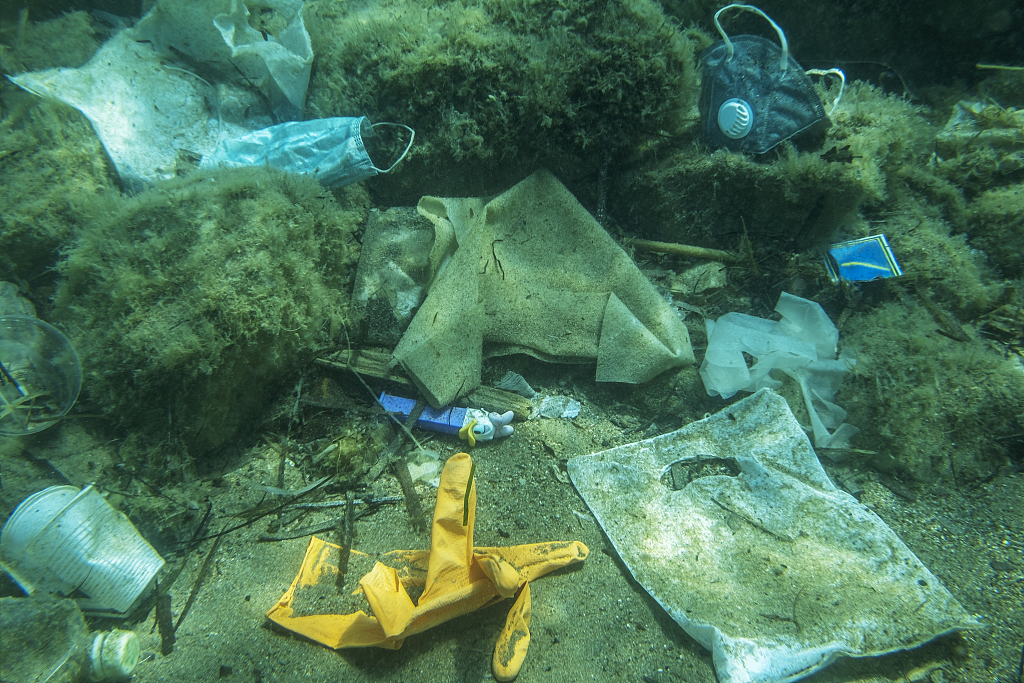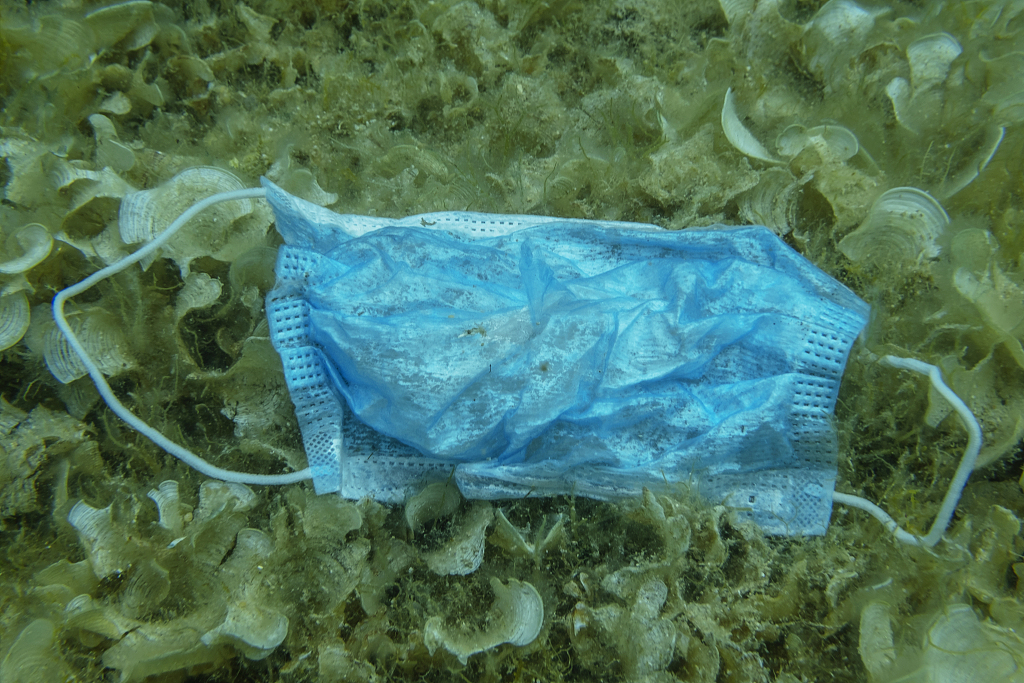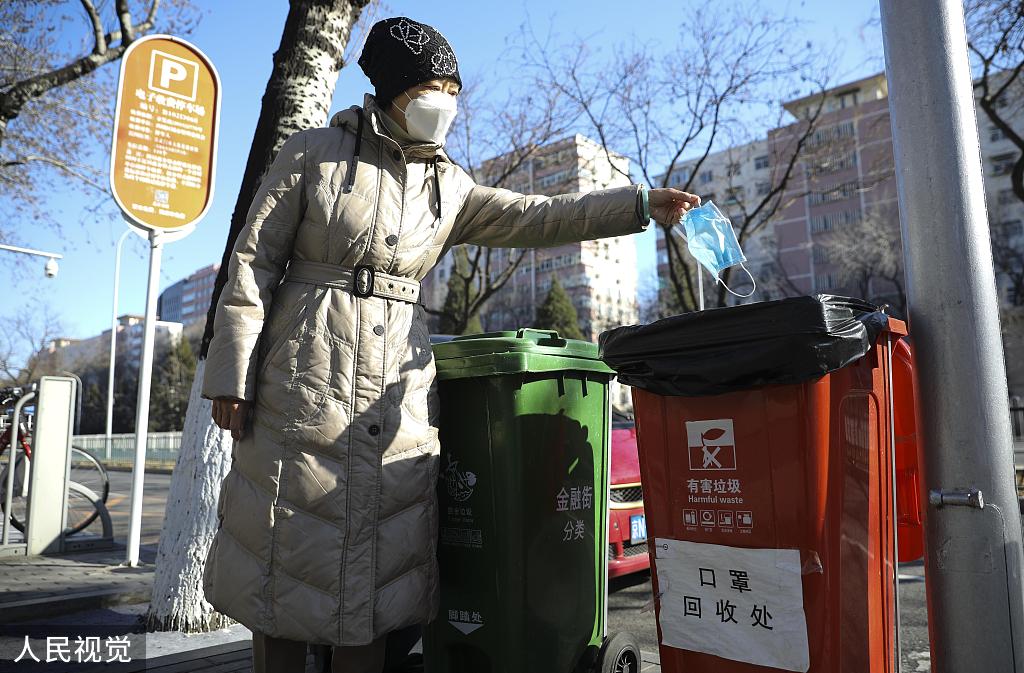
Masks and other garbage polluting the Adriatic Sea, July 31, 2020. /CFP
Masks and other garbage polluting the Adriatic Sea, July 31, 2020. /CFP
Editor's note: According to the latest report released by the marine conservation organization OceansAsia in December 2020, there were 1.56 billion masks estimated to have entered our oceans in 2020. It amounted to between 4,680 and 6,240 metric tons of plastic pollution, and would take as long as 450 years to break down, posing negative impact to marine wildlife and ecosystems.
In a time threatened by the COVID-19 pandemic, masks are one of the most efficient means to protect ourselves from the spread of the virus. As many countries mandate the wearing of masks in public, the demand and production of single-used surgical masks have rocketed. In June 2020, the World Health Organization (WHO) estimated that 129 billion face masks would be needed on a monthly basis to protect people worldwide.
However, at a time when face masks have become a standard accessory for everyone, it is crucial to understand how it threatens our environment and how to deal with them properly. When single-use masks are not disposed of properly, they pose serious threat to our ecosystem.
In Malaysia, abandoned masks are found scattered around areas where wild macaques inhabit. The macaques have been spotted chewing these masks – a potential choking hazard for the diminutive monkeys. In Britain, a gull was rescued after its legs became tangled in the straps of a disposable mask for up to a week. In Brazil, conservationists found a mask inside the stomach of a penguin after its body was washed up on a beach, while a dead pufferfish was discovered caught inside another off the coast of Miami in the United States.

Macaque monkeys attempt to eat parts of a face mask in Genting Sempah, Malaysia's Pahang state, October 30, 2020. /CFP
Macaque monkeys attempt to eat parts of a face mask in Genting Sempah, Malaysia's Pahang state, October 30, 2020. /CFP
Polluting our oceans
With a global production projection of 52 billion masks for 2020, OceansAsia developed a formula and estimated that there were 1.56 million masks, conservatively three percent of the total produced masks, entering our oceans.
Single-use face masks are made from a variety of melt-blown plastics and are difficult to recycle due to both the composition and risk of contamination and infection. These masks enter the ocean as litter or when waste management systems are overwhelmed by increasing volumes of waste.
Once a mask enters the ocean, the melt-blown polypropylene and polyethlene that make up a mask becomes a source of microplastic throughout the 450-year-long decomposition process, while ear loops of a mask pose an entanglement risk for marine wildlife. Masks are also prone to algal growth compared with other plastics, which increases the chance of it being mistaken as food and swallowed by marine wildlife.

Used masks enter the ocean and are prone to algal growth. /CFP
Used masks enter the ocean and are prone to algal growth. /CFP
Solutions
Conservation groups around the world have voiced the importance of containing threats posed by increasing amount of abandoned masks. However, the proper way of recycling used masks are still not implemented in most countries.
A key factor that frustrates the recycling process of masks is that most masks are manufactured using multiple materials. Experts are calling for masks to be made from polymer alone, which would make recycling much easier. Until then it is advised to dispose them separately in designated bins. More importantly, the straps on the masks should be cut off to prevent potential entanglement risks for wildlife.

In China, separate disposal bins have been implemented not only in hospitals, but also in residential areas, Beijing, March 2020. /CFP
In China, separate disposal bins have been implemented not only in hospitals, but also in residential areas, Beijing, March 2020. /CFP
Degradable or reusable masks are also solutions to prevent ocean pollution. There are a number of designers and scientists making masks with biodegradable materials such as plant fiber.
Government policy is crucial when it comes to promoting proper disposal of used masks. Creating easy-access disposal system is as important as raising public awareness of reducing the threat of discarded masks. Apart from that, government incentives for innovations and technological development in producing reusable or degradable masks would also play a positive role in protecting our environment.
(With input from AFP and data from OceansAsia. All images via CFP.)
(If you want to contribute and have specific expertise, please contact us at nature@cgtn.com.)

